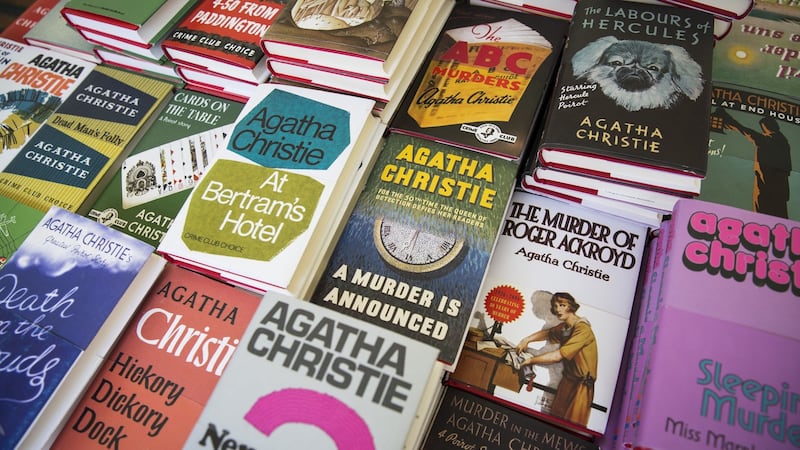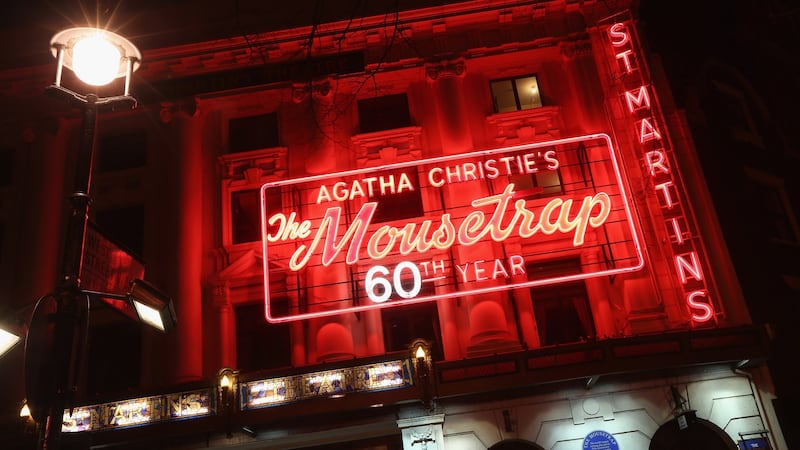When asked which writers have influenced me, I usually say Flannery O’Connor and Gabriel García Márquez. As a lapsed Presbyterian magic realist, I’m the love child this pair would never have had. But the truth is I came relatively late to the kind of books you’re supposed to read. If I’m being entirely honest, the writer who has most shaped me is the late, great Agatha Christie. I’ve been modelling myself on her for years.
I first encountered Christie at the unlikely age of eight. Having devoured all the books in the children’s section of Ballymena library, I wandered into crime and picked up Murder in the Clouds. It was clever, vicious and, most importantly, not meant for children. I was instantly hooked. Overnight I transitioned from Nancy Drew (who dabbled in robberies and the odd kidnapping) to Agatha Christie (who liked to murder liberally).
Six months later I read And Then There Were None. It gave me nightmares. This was a large part of the appeal. Agatha Christie became my gateway drug to Sherlock Holmes, Bram Stoker, Emily Brontë and Stephen King. I was on a slippery slope.
My parents never curtailed my reading, unsuitable though it might’ve been. I think my dad was actually glad I’d discovered crime. Dad’s a Christie fan himself. We soon fell into the habit of watching her adaptations together. Even now, Christmas wouldn’t be Christmas if we didn’t squeeze in a Poirot or two. We don’t mind watching repeats. Poirot’s just the excuse we use to spend a few hours together, sharing something we love.
Agatha Christie is one of the constants running through my life. As a child I loved the language of her books. I frequently paused my reading to look up words in the dictionary. Unscrupulous. Macabre. Arsenic. Nobody talked like this in Ballymena. I filed my new words away for later use.
Christie kept me company as a teenager when I spent long stretches in hospital unable to concentrate on anything but her novels. Later, we travelled around the world together. Her paperbacks, tucked into my rucksack pocket, were devoured on trains and airplanes. Fifteen years ago, when I started writing seriously, I re-read her biography and found a blueprint for the kind of writer I wanted to be.
She read Graham Greene and Muriel Spark, and a host of other contemporaries, championing their writing though it was wildly different from hers
A huge part of writing is coming to terms with the kind of writer you are. Early on I realised that – as in life – I would never be the less-is-more type. I write a lot. I overwrite. I have far too many ideas. I am jealous of those careful, slow writers who take a decade over a book. They seem serious and earnest, whilst I feel slapdash and over-eager, like a little kid, acting up.
I’m often embarrassed by my creative output. This peaked during lockdown. Others were – quite understandably – struggling to write, while I used productivity as a coping mechanism, writing enormous amounts of mostly drivel. Perhaps it wasn’t the healthiest way to navigate a pandemic, but it beat heavy drinking or heroin. I knew no other way to cope.
‘More is more’
Agatha Christie has always made me feel better about being a “more is more” person. She was the very definition of prolific. Her writing career, spanning six decades, included 66 crime novels, 14 story collections and numerous plays. In 1934 alone she published five entire novels. Her imagination outpaced her prodigious literary output. The dozens of notebooks she left behind, lovingly collated by John Curran, reveal countless undeveloped ideas, such as the tantalising “legless man – sometimes tall – sometimes short” (proof, perhaps, that Christie was a closet magic realist).
Christie played a long game with her writing, constantly learning and developing. Her work peaks mid-career but, even in her late 70s, she was still astounding readers with her quick wit and clever plots. Her popularity remains undiminished almost 45 years after her death. With somewhere between two and four billion books sold in a hundred languages, she is among the world’s most successful authors, second only to Shakespeare – and there’s no speculation about who actually wrote her plays and books.

Christie reminds me that there’s no one way write. She read Graham Greene, Muriel Spark and a host of other contemporaries, championing their writing though they were wildly different from hers. She wrote the stories that she could write, and she wrote a lot of them. Some writers have one book in them. Others have a hundred or more. I suspect that I’ll fall somewhere in between. Christie taught me that comparison does not serve the writer well.
Her influence is enormous, yet she took a remarkably pragmatic attitude to her writing. She was always honest and objective about her work, quick to play the critic. She wasn’t pleased with how The Mystery of the Blue Train turned out and, in a letter to a friend, summed up another, later novel as “not as good as Roger Ackroyd, but not too bad”.
Writerliness
She never glamorised the writer’s role. Repeatedly in her autobiography she talks about writing as something done to pay the bills. Twenty novels in she introduced Ariadne Oliver, a fictional lady novelist, and used this character to lambast her own writerliness. In Dead Man’s Folly, Miss Oliver echoes Christie’s own matter-of-fact views on writing:
“I mean, what can you say about how you write your books? What I mean is, first you’ve got to think of something, and then when you’ve thought of it you’ve got to force yourself to sit down and write it. That’s all.”
I sometimes wonder what Agatha Christie would make of the current literary world where writers often spend more time talking about the act than actually writing. I don’t think she’d have much time for it. She was notably shy of the PR circus that came with being a celebrated author. And yet, I believe she also took her calling seriously. She revelled in the act of writing and took due pleasure in what she wrote. Upon receiving positive reviews of her (now acknowledged) masterpiece, And Then There Were None, she wrote, “the person who was really pleased with it was myself, for I knew better than any critic how difficult it had been.”
During the first weeks of lockdown when my anxiety was at its peak, I spent hours in bed, self-soothing with Miss Marple paperbacks and classic Poirot episodes
I suspect Agatha Christie understood the difference between being a writer and actually writing, and placed proper emphasis on the latter act. I’d do well to remember this, on those days when the public role of author keeps me away from my writing desk.
Finally, and perhaps a little strangely – for, while she dabbles with the occult in Dumb Witness and The Pale Horse, she was almost exclusively a realist – I love Christie because I am drawn to the fantastic. As a magic realist, I’m constantly trying to upset my readers’ assumptions about reality. No writer questions the veracity of everyone and everything as effectively as Agatha Christie does. Her typical mise en scene has the suspects gathered in a room while Poirot or, occasionally Marple, unpicks each person’s defence in turn, proving they are not what they seem and are infinitely capable of murder, regardless of whether they’ve actually killed or not.
Suspension of disbelief
This deeply unsettling model, now mirrored in almost every crime drama from Broadchurch to last year’s excellent Knives Out, requires delicately maintaining the suspension of disbelief while the reader questions everything she thinks she knows. Christie’s method is sleight of hand: laying such a subtle breadcrumb trail, the fantastic revelation in the final act has been carefully foreshadowed from the start. Her great skill is in delivering a shock that is not a surprise.
I’d argue that the fantastic element in magic realism should work in a similarly convincing but unsettling way. I’ve learned more about challenging the reader’s assumptions from Christie’s novels than from those writers who’ve made their names chronicling the unreal. Each time I pick up one of her stories, I seem to learn something new.

Back in the carefree days of autumn 2019, I set myself a reading challenge for 2020: to mark the centenary of Agatha Christie’s first published book, I’d read all her crime fiction novels, chronologically, in a single year.
On January 1st, as I began The Mysterious Affair at Styles, I had no idea what 2020 held in store or how Agatha Christie and her stories would help me navigate the strange times ahead. During the first weeks of lockdown, when my anxiety was at its peak, I spent hours in bed, self-soothing with Miss Marple paperbacks and classic Poirot episodes.
I wasn’t the only one who turned to the Queen of Crime in their hour of need. Several booksellers reported that sales of Christie rose sharply during lockdown. Perhaps, like me and my dad, these readers found comfort in revisiting familiar stories and characters. Perhaps there is also a subtler, moral comfort in Christie’s insistence that wickedness will be punished, and sense made of even the most heinous crime.
In his 1946 essay Decline of the English Murder, George Orwell wrote that “crimes as serious as murder should have strong emotions behind them”. Christie’s brand of crime is ordered, methodical and never without clear motive. If 2020 were a crime novel, it’d be more of a senseless killing spree. In light of the chaotic state of the world, Christie’s brand of logical murders and justice served has felt like a kind of soothing balm.
If only Poirot could be convinced to abandon those infamous vegetable marrows and un-retire for the umpteenth time, I suspect he’d be able to use his “little grey cells” to make sense of the state we now find ourselves in.
Jan Carson’s latest novel is The Fire Starters
Top Ten Agatha Christies (in no particular order)
1. A Murder Is Announced Definitely Miss Marple's finest hour, crammed full of classic Christie tropes.
2. Five Little Pigs Christie delivering some of her finest depictions of characters as Poirot revisits a case long closed.
3. And Then There Were None If you only read one, this is undoubtedly her masterpiece. (The body count is exceptionally high.)
4. Crooked House Proof, if needed, that Christie wasn't as cosy as people thought she was.
5. The Mysterious Affair at Styles Enter Poirot, an essential introduction to Christie's finest creation.
6. The Murder of Roger Ackroyd One of the best plot twists in the entire history of crime fiction.
7. Why Didn't They Ask Evans? A personal favourite for its high camp depiction of the Jeeves and Wooster set.
8. Murder on the Orient Express One of Christie's most complicated and sophisticated murders, complete with the solution to end all solutions.
9. The ABC Murders Fast-paced, devious and full of subtlety, a much underrated Poirot case.
10. The Body in the Library Miss Marple has to deal with body swapping, blonde bombshells and some rather bohemian types, and unsurprisingly takes it all in her stride.









